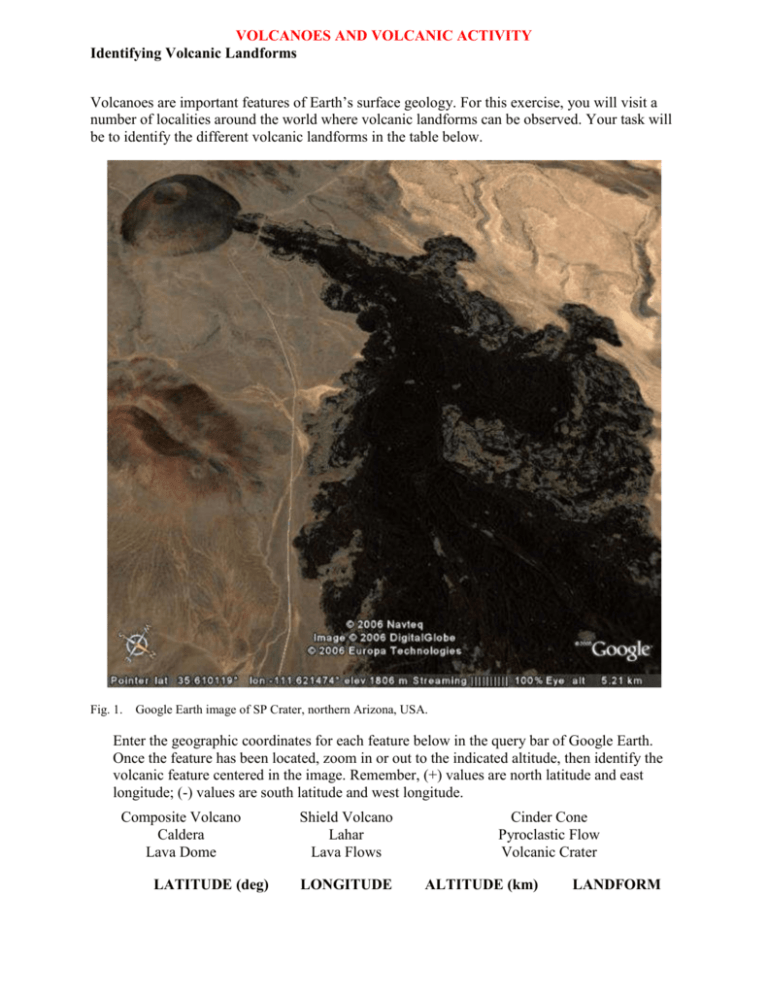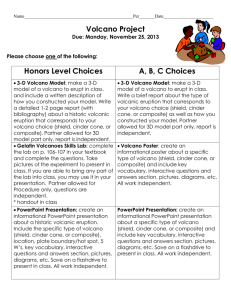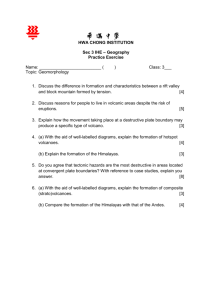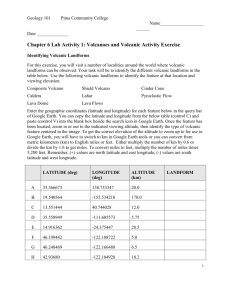MINING AND NATURAL RESOURCES
advertisement

VOLCANOES AND VOLCANIC ACTIVITY Identifying Volcanic Landforms Volcanoes are important features of Earth’s surface geology. For this exercise, you will visit a number of localities around the world where volcanic landforms can be observed. Your task will be to identify the different volcanic landforms in the table below. Fig. 1. Google Earth image of SP Crater, northern Arizona, USA. Enter the geographic coordinates for each feature below in the query bar of Google Earth. Once the feature has been located, zoom in or out to the indicated altitude, then identify the volcanic feature centered in the image. Remember, (+) values are north latitude and east longitude; (-) values are south latitude and west longitude. Composite Volcano Caldera Lava Dome LATITUDE (deg) Shield Volcano Lahar Lava Flows LONGITUDE Cinder Cone Pyroclastic Flow Volcanic Crater ALTITUDE (km) LANDFORM (deg) A 35.366673 138.733347 20.0 Composite volcano B 19.540564 -155.534218 170.0 Shield volcano C 13.551444 40.744028 12.0 Lava flow or fissure eruption D 35.558949 -111.605573 8.00 Cinder cone E 14.916362 -24.375447 28.5 Composite volcano F -0.378905 -91.514776 32 Shield volcano G 50.855056 155.558648 18 Composite volcano H 46.199442 -122.188722 5.0 Lava dome I 46.248469 -122.166488 6.5 Pyroclastic flow J 42.93680 -122.104928 18.2 Caldera K 41.587152 -122.474640 14.8 Pyroclastic Flow L 56.569979 158.579963 7.9 Shield volcano M 41.396334 -122.19003 19.0 Composite volcano N -3.064728 37.358316 11.9 Volcanic crater O 14.986742 120.222811 14 Lahar P 13.254101 123.685199 15 Composite volcano Q 2.425559 98.842043 68.5 Caldera R -7.951140 112.951327 13.2 Caldera ADDITIONAL QUESTIONS: 1. What type of volcanic rocks would you expect to be erupted from ‘B’ above? basalt 2. Of what type volcanic rock do you think the feature in ‘H’ is composed? Intermediate or andesitic 3. Use the ‘Measure’ tool to estimate the diameter of the feature in ‘J’. What is the diameter of this feature? 9-10 km 4. The feature in ‘J’ is approximately circular. What is its area? ca. 78 km2 5. Use the ‘Measure’ tool in Google Earth to determine the distance from the feature in ‘K’ and the summit of its parent volcano. How far is it? ca. 30 km 6. Use the ‘Measure’ tool in Google Earth to determine the distance from the feature in ‘O’ and the summit of its parent volcano. How far is it? ca. 20 km 7. Use the ‘Measure’ tool to determine the length and width of the feature in ‘Q’. ca. 85 x 27 km 8. Find a composite volcano (stratovolcano) that is not featured above; save and print the image with a brief description of it for your instructor. 9. Find a shield volcano that is not featured above; save and print the image with a brief description of it for your instructor. LINKS TO RELATED SITES: Wikipedia entry on shield volcanoes: http://en.wikipedia.org/wiki/Shield_volcano Wikipedia entry on composite volcanoes: http://en.wikipedia.org/wiki/Composite_volcano Wikipedia entry on lava flows: http://en.wikipedia.org/wiki/Lava_flow Wikipedia entry on calderas: http://en.wikipedia.org/wiki/Caldera Wikipedia entry on pyroclastic flows: http://en.wikipedia.org/wiki/Pyroclastic_flow Wikipedia entry on lahars: http://en.wikipedia.org/wiki/Lahar Wikipedia entry on cinder cones: http://en.wikipedia.org/wiki/Cinder_cone









